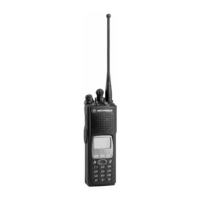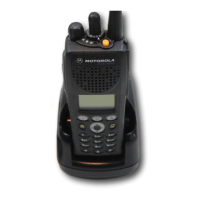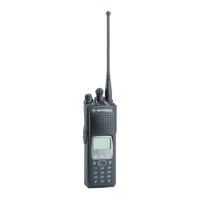Disassembly/Reassembly Procedures
55
4. Attach the open end of the hose to the adapter.
5. Place the radio on a flat surface with the casting facing upward.
Place two or three drops of water on each slot of the label (62)
that protects the vent port seal (61) on the casting. This will
ensure that no air goes through the seal.
6. Operate the pump a few times until the gauge indicates 5 in. Hg;
do not pull more than 7 in. Hg of vacuum on the radio.
Operate the pump again until the gauge indicates 6 in. Hg.
7. Observe the gauge for approximately 1 minute.
• If the needle falls 1 in. Hg or less (for example, from 6 in. Hg
to 5 in. Hg), then the radio has passed the vacuum test and is
approved for submergibility. No additional testing will be
required.
• If the needle falls more than 1 in. Hg (for example, from 6 in.
Hg to less than 5 in. Hg), then the radio has failed the vacuum
test and the radio might leak if submerged. Additional
troubleshooting of the radio will be required; complete this
procedure, then go to the “Pressure Test” section of this
manual.
8. Dry the water from the slots on the label (62) that protects the
vent port seal to allow the radio to equalize. The pressure should
drop slowly to “0.”
9. Remove the vacuum hose and adapter from the radio.
10. Install the vacuum test port plug by pressing it in, ensuring that
the plug sits flat all around the edges and it is flush with the
casting.
Pressure Test Refer to the exploded view diagrams and parts lists in this manual.
General Pressure testing the radio is necessary only if the radio has failed the
vacuum test. Do not perform the pressure test until the vacuum test
has been completed. Pressure testing involves creating a positive
pressure condition inside the radio, submerging the radio in water,
and observing the radio for a stream of bubbles (leak). Since all areas
of the radio are being checked, observe the entire unit carefully for the
possibility of multiple leaks before completing this test.
Conducting the Test 1. Remove the vacuum test port using a pair of needle-nosed pliers
and pulling upward.
2. Screw the adapter (with gasket) into the tapped hole in the
casting.
3. Attach one end of the pressure hose to the adapter and the other
end to the pressure pump.
4. Cover the vent port seal (61) and label (62) on the back of the
casting with your thumb. This will prevent air from going
through the seal. Keep the vent port covered with your thumb
until the test is complete (through step 8).
5. Operate the pump until the gauge reads approximately 1 psig.

